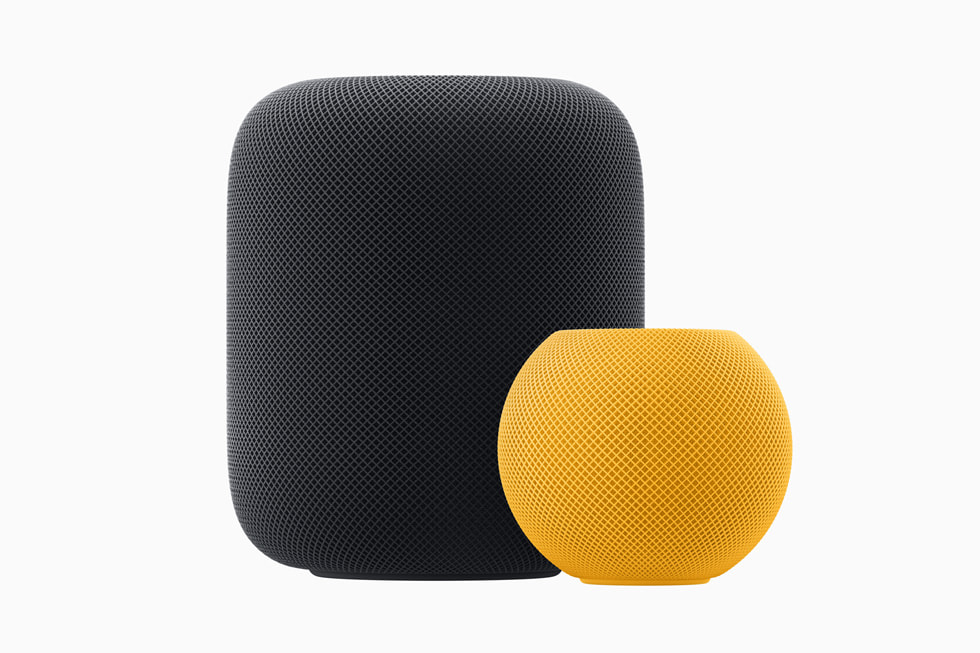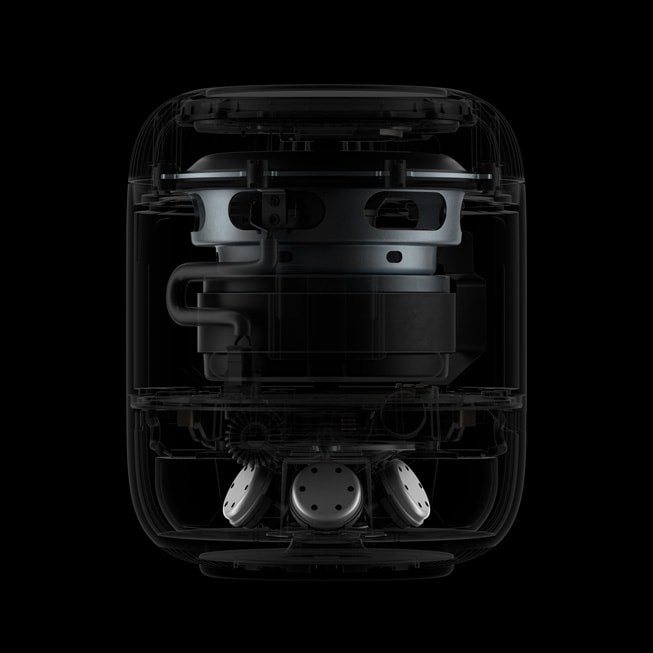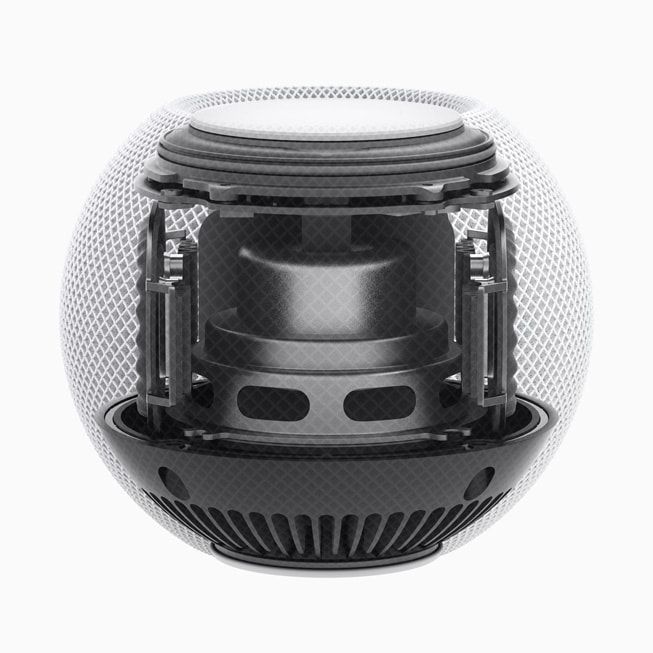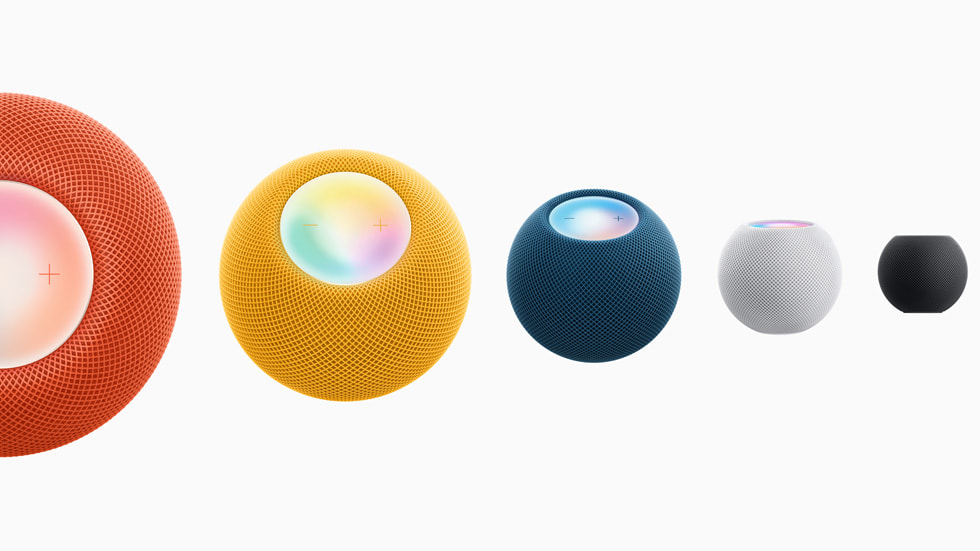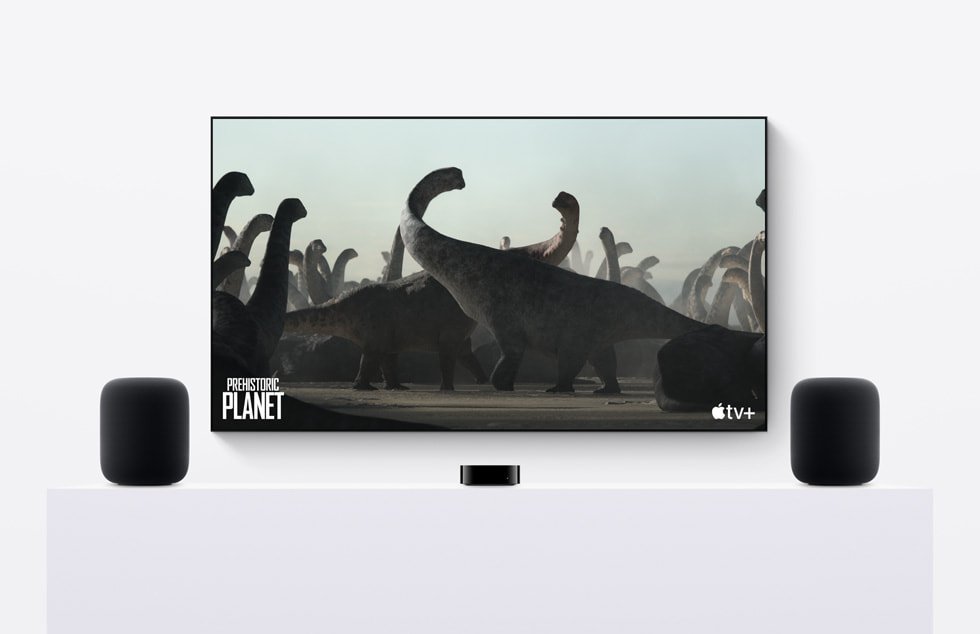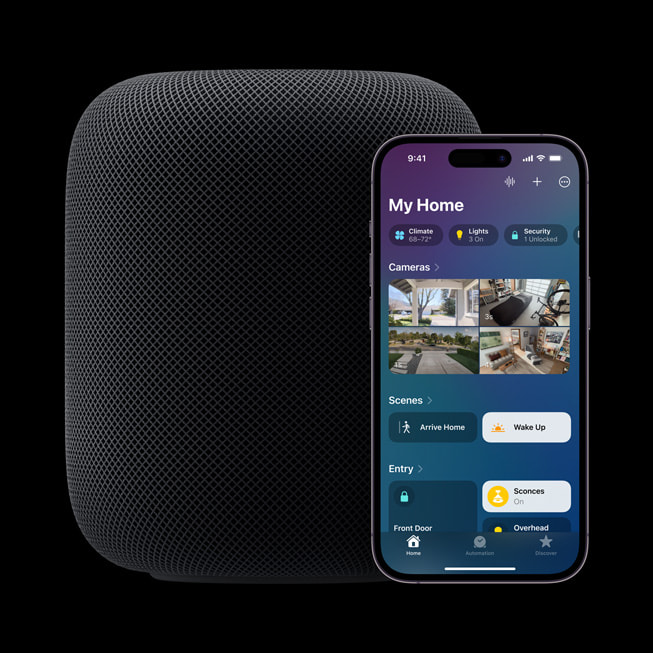UPDATE
04 May 2023
Apple introduces HomePod and HomePod mini in Luxembourg
The HomePod lineup delivers impressive sound, enhanced Siri capabilities, and a safe and secure smart home experience
Apple today announced HomePod (2nd generation) and HomePod mini are available in Luxembourg starting today, bringing stunning audio experiences to every space in the home. Designed to work in perfect harmony, the new HomePod leverages advanced computational audio to deliver groundbreaking acoustics, while HomePod mini offers big sound in a beautifully compact design.
HomePod and HomePod mini users can listen to a catalog of over 100 million songs with Apple Music;1 enjoy room-filling audio with a single speaker, in a stereo pair, and using multiroom audio; or create a captivating home theater experience with Apple TV 4K. With Siri, users can access a range of music knowledge, and search by artist, song, lyrics, decade, genre, mood, or activity.
Packed with innovations and Siri intelligence, both speakers provide convenient ways to manage everyday tasks and control the smart home. Users can create smart home automations using Siri, get notified when a smoke or carbon monoxide alarm is detected in their home, check temperature and humidity in a room, and use Intercom to send an announcement throughout the house — all hands-free.
Amazing Sound
HomePod delivers captivating audio quality, with rich, deep bass and stunning high frequencies, including support for immersive Spatial Audio tracks. A custom-engineered high-excursion woofer that drives the diaphragm a remarkable 20mm, built-in bass-EQ mic, and beamforming array of five tweeters around the base all work together to achieve a powerful acoustic experience. The S7 chip is combined with software and system-sensing technology to offer even more advanced computational audio that maximizes the full potential of its acoustic system for a groundbreaking listening experience.
With room sensing technology, HomePod recognizes sound reflections from nearby surfaces to determine if it is against a wall or freestanding, and then adapts sound in real time. Precise directional control of its beamforming array of five tweeters separates and beams direct and ambient audio, immersing listeners in crystal-clear vocals and rich instrumentation.
HomePod mini features an Apple-designed acoustic waveguide to direct the flow of sound down and out toward the bottom of the speaker for an immersive 360-degree audio experience. This allows customers to place HomePod mini almost anywhere in a room and hear consistent sound. A three-microphone array listens for “Hey Siri,” and a fourth inward-facing microphone helps isolate sound coming from the speaker to improve voice detection when music is playing.
To achieve big sound out of such a compact design, the Apple S5 chip in HomePod mini works with advanced software to analyze the unique characteristics of the music and apply complex tuning models to optimize volume, adjust the dynamic range, and control the movement of the driver and passive radiators in real time. The Apple-engineered full-range driver, powered by a neodymium magnet and a pair of force-cancelling passive radiators, enables deep bass and crisp high frequencies.
Refined Design
With a seamless, acoustically transparent mesh fabric and a backlit touch surface that illuminates from edge to edge, HomePod and HomePod mini boast a beautiful design that complements any space.
HomePod is available in white and midnight — a new color made with 100 percent recycled mesh fabric — while HomePod mini comes in bold hues to add a pop of color to the home, including orange, yellow, and blue, as well as space gray and white. Both HomePod and HomePod mini come with a color-matched woven power cable.
Elevated Experience with Multiple HomePod Speakers
Two or more HomePod or HomePod mini speakers unlock a variety of powerful features. Using multiroom audio with AirPlay,2 users can simply say “Hey Siri,” or touch and hold the top of HomePod or HomePod mini to play the same song on multiple speakers, play different songs on different speakers, or even use them as an intercom to broadcast messages to other rooms.
Users can also create a stereo pair with two HomePod or HomePod mini speakers in the same space.3 In addition to separating the left and right channels, a stereo pair plays each channel in perfect harmony for a truly standout listening experience.
Seamless Integration with the Apple Ecosystem
Leveraging Ultra Wideband technology, users can hand off whatever they’re playing on iPhone — like a favorite song, podcast, or even a phone call — directly to HomePod or HomePod mini.4 To easily control what’s playing or receive personalized song and podcast recommendations, anyone in the home can bring an iPhone close to HomePod or HomePod mini, and suggestions will surface automatically. The HomePod lineup can also recognize up to six voices, so each member of the home can hear their personal playlists, ask for reminders, and set calendar events.
The HomePod lineup easily pairs with Apple TV 4K for a powerful home theater experience, and eARC (Enhanced Audio Return Channel)5 support on Apple TV 4K enables customers to make HomePod or HomePod mini the audio system for all devices connected to the TV. Plus, with Siri on HomePod and HomePod mini, users can control what’s playing on their Apple TV hands-free.
Find My on HomePod and HomePod mini makes it possible for users to locate their Apple devices, like an iPhone, by playing a sound on the misplaced device. Using Siri, users can also ask for the location of friends or loved ones who share their location via the app.
Smart Home Essentials
With Sound Recognition,6 the HomePod lineup can listen for smoke and carbon monoxide alarms, and send a notification directly to the user’s iPhone if a sound is identified. The new built-in temperature and humidity sensor7 can measure indoor environments, so users can create automations that close the blinds or turn on the fan automatically when a certain temperature is reached in a room.
By activating Siri, customers can control a single device or create scenes like “Good Morning” that put multiple smart home accessories to work at the same time, or set up recurring automations hands-free like “Hey Siri, open the blinds every day at 6 a.m.”8 A new confirmation tone indicates when a Siri request is made to control an accessory that may not visibly show a change, like a heater, or for accessories located in a different room. Ambient sounds — like ocean, forest, and rain — have also been remastered and are more integrated into the experience, enabling customers to add new sounds to scenes, automations, and alarms.
Users can also intuitively navigate, view, and organize accessories with the redesigned Home app, which offers categories for climate, lights, and security; enables easy setup and control of the smart home; and includes a beautiful multicamera view.
Matter Support
Matter enables smart home products to work across ecosystems while maintaining the highest levels of security. Apple is a member of the Connectivity Standards Alliance, which maintains the Matter standard, along with other industry leaders. HomePod and HomePod mini connect to and control Matter-enabled accessories, and serve as essential home hubs, giving users access to their smart home accessories when away from home.
Customer Data Is Private Property
Protecting customer privacy is one of Apple’s core values. Siri uses advanced machine learning to understand user preferences without sharing their identity with Apple or anyone else. When Siri is used, the audio of the request is not stored by default, and is associated with a random identifier, not an Apple ID. All Apple Home communications are end-to-end encrypted so they can’t be read by Apple, including Intercom and camera recordings with HomeKit Secure Video. These features give customers peace of mind that their privacy is protected at home.
HomePod and the Environment
HomePod and HomePod mini were designed with the environment in mind. They include 100 percent recycled rare earth elements in the speaker magnets and recycled plastic in the mesh fabric — including 100 percent recycled plastic in HomePod’s new midnight fabric. HomePod also features 100 percent recycled gold in the plating of multiple printed circuit boards. All of the wood fibers in the packaging come from responsible and recycled sources. Both speakers are free of mercury, brominated flame retardants, PVC, and beryllium.
HomePod and HomePod mini use power-efficient components and software that intelligently power the devices down during periods of inactivity. For example, through optimized power management features and a high-efficiency power supply, HomePod and HomePod mini have been designed to be efficient in their low-power mode, where the majority of their time is spent. The result is HomePod and HomePod mini are energy efficient right out of the box, and consume around 75 percent less energy than the most stringent requirements for ENERGY STAR. Today, Apple is carbon neutral for global corporate operations, and by 2030, plans to be 100 percent carbon neutral across the entire manufacturing supply chain and the life cycle of every product. This means that every Apple device sold — including HomePod and HomePod mini — will have net-zero climate impact.
Pricing and Availability
- Customers in Luxembourg can purchase HomePod (2nd generation) for $299.00 and HomePod mini for $99.00 from apple.com/lu/store, and in the Apple Store app today.
- HomePod (2nd generation) is compatible with iPhone SE (2nd generation) and later, or iPhone 8 and later running iOS 16.3 or later; or iPad Pro, iPad (5th generation) and later, iPad Air (3rd generation) and later, or iPad mini (5th generation) and later running iPadOS 16.3.
- HomePod mini is compatible with iPhone SE, iPhone 6s or later, or iPod touch (7th generation) with the latest version of iOS; or iPad Pro, iPad (5th generation or later), iPad Air 2 or later, or iPad mini 4 or later with the latest version of iPadOS.
- New subscribers can get Apple Music free for six months with the purchase of any HomePod or HomePod mini.
Media
-
Text of this article
-
Images in this article
- Apple Music requires a subscription.
- Multiroom audio requires multiple HomePod speakers or AirPlay-compatible speakers with the latest AirPlay software.
- Creating a HomePod stereo pair requires two of the same model HomePod speakers, such as two HomePod mini, two HomePod (2nd generation), or two HomePod (1st generation).
- iOS 16.3 is required on iPhone for Handoff on HomePod.
- Home theater with eARC support requires Apple TV 4K (2nd generation) or later, running the latest tvOS software.
- Sound Recognition may detect smoke and carbon monoxide alarm sounds and send notifications when recognized. Sound Recognition should not be relied upon in circumstances where the user may be harmed or injured, or in high-risk or emergency situations. Sound Recognition requires the updated Home architecture, which is available as a separate update in the Home app. It requires all Apple devices that access the home to be using the latest software.
- Temperature and humidity sensing is optimized for indoor, domestic settings, when ambient temperatures are around 15º C to 30º C and relative humidity is around 30 percent to 70 percent. Accuracy may decrease in some situations where audio is playing for an extended period of time at high volume levels. HomePod requires some time to calibrate the sensors immediately after starting up before results are displayed.
- Smart home accessories are sold separately.
